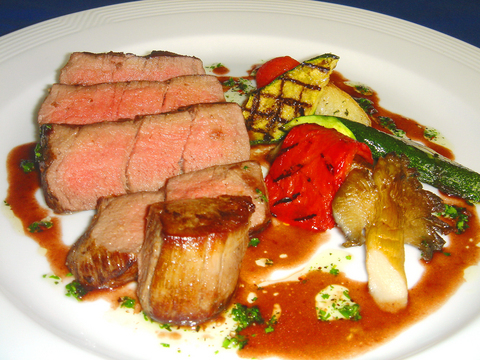Opened as a private members' restaurant in September 2004, Tianmu 101 opened its doors to the masses six months ago. It does, however, retain a feel of exclusivity.
Designed by architect Wu Ching-yi (吳清義), the establishment won an ROC Association of Interior Design and Decoration award last year and is done out with more than a passing nod to Mediterranean aesthetic sensibilities.
The finesse is in the details. Great thought has been given to texture -- an antique leather sofa put together with velvet covered contemporary chairs, chunky wooden bar tops and solid brick walls. The salon prive on the second floor can sit up to eight. There is a minimum charge of NT$2,500 per person for the added privacy.

PHOTO: STEVE PRICE, TAIPEI TIMES
Having worked as head chef at several five-star hotels -- in Singapore, Beijing and Hong Kong -- Edward Song (宋國傑) has the credentials and expertise to justifiably charge patrons high prices for the set menus.
Song formerly worked at Le Petite Cuisine, which made it onto Taipei Times' list of top 10 restaurants of last year.
The lunch special at NT$580 excluding service charge is a bargain. Choices include Mesclun salad with smoked duck breast, squid tagliatelle with shellfish and tomato sauce, and braised ocean fish with mushroom sauce.
The soup of the day was served in an espresso cup and initial thoughts of gimmickry, or style over substance were soon dispelled. The seafood broth had such an intense flavor that a whole bowlful would not have been over the top.
Song takes advantage of Taiwan's plentiful supply of fresh fish and said seafood was his passion -- an example being the pan fried parrot fish served with butter and white wine sauce. Classic lobster thermidor is available on the special set menu.
The boldest dish was the pan-fried beef tenderloin served with char-grilled vegetables. The beef, imported from New Zealand, is smoked on the premises with a mixture of wood chips and Chinese tea leaves, which produces a taste sensation. Many chefs go to great pains to meld dishes of contrasting or complimentary flavors, but Song has been brave enough to let this dish stand on it's main constituent.

June 2 to June 8 Taiwan’s woodcutters believe that if they see even one speck of red in their cooked rice, no matter how small, an accident is going to happen. Peng Chin-tian (彭錦田) swears that this has proven to be true at every stop during his decades-long career in the logging industry. Along with mining, timber harvesting was once considered the most dangerous profession in Taiwan. Not only were mishaps common during all stages of processing, it was difficult to transport the injured to get medical treatment. Many died during the arduous journey. Peng recounts some of his accidents in

“Why does Taiwan identity decline?”a group of researchers lead by University of Nevada political scientist Austin Wang (王宏恩) asked in a recent paper. After all, it is not difficult to explain the rise in Taiwanese identity after the early 1990s. But no model predicted its decline during the 2016-2018 period, they say. After testing various alternative explanations, Wang et al argue that the fall-off in Taiwanese identity during that period is related to voter hedging based on the performance of the Democratic Progressive Party (DPP). Since the DPP is perceived as the guardian of Taiwan identity, when it performs well,

The Taiwan People’s Party (TPP) on May 18 held a rally in Taichung to mark the anniversary of President William Lai’s (賴清德) inauguration on May 20. The title of the rally could be loosely translated to “May 18 recall fraudulent goods” (518退貨ㄌㄨㄚˋ!). Unlike in English, where the terms are the same, “recall” (退貨) in this context refers to product recalls due to damaged, defective or fraudulent merchandise, not the political recalls (罷免) currently dominating the headlines. I attended the rally to determine if the impression was correct that the TPP under party Chairman Huang Kuo-Chang (黃國昌) had little of a

A short walk beneath the dense Amazon canopy, the forest abruptly opens up. Fallen logs are rotting, the trees grow sparser and the temperature rises in places sunlight hits the ground. This is what 24 years of severe drought looks like in the world’s largest rainforest. But this patch of degraded forest, about the size of a soccer field, is a scientific experiment. Launched in 2000 by Brazilian and British scientists, Esecaflor — short for “Forest Drought Study Project” in Portuguese — set out to simulate a future in which the changing climate could deplete the Amazon of rainfall. It is